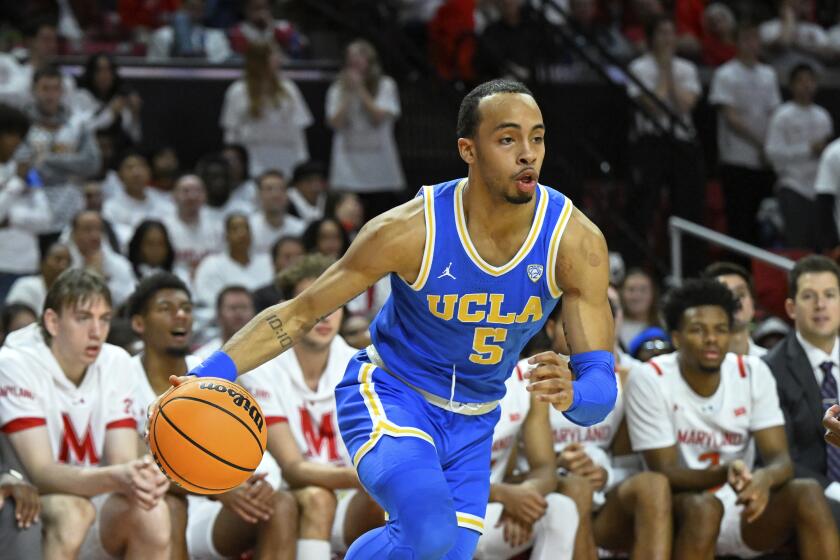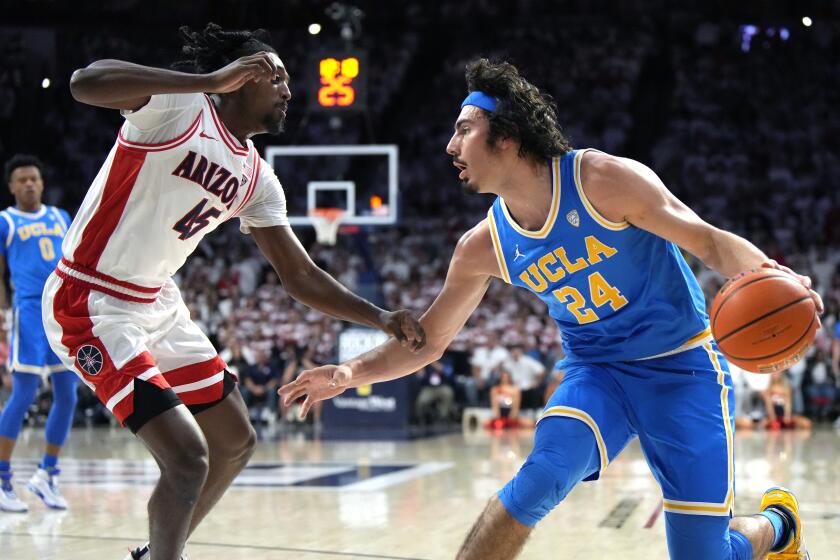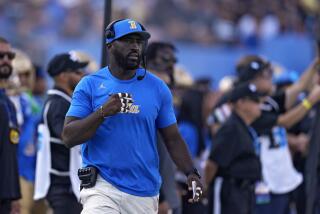UCLA makes progress while posting a $28-million athletic department deficit

- Share via
When UCLA welcomed back fans amid the waning pandemic, it also hailed an accompanying benefit.
Revenue. Lots of it.
Profits from ticket sales and media rights fees related to schedules returning much closer to normal helped the Bruins more than halve the athletic department deficit from the previous fiscal year.
UCLA’s debt of $28.045 million during the 2022 fiscal year was less than half the record $62.5 million from 2021, though it still left the athletic department facing a hefty four-year shortfall of $130.8 million roughly 1½ years before it can tap a spigot of cash from the Big Ten Conference.
Amari Bailey, the freshman guard who missed the last seven games with discomfort in his left foot, is available to return against USC, coach Mick Cronin said.
That deficit will drop by more than half after a judge last summer awarded UCLA a $67.5-million settlement as part of its lawsuit against Under Armour for unilaterally terminating its record apparel agreement with the school..
That lump sum will temporarily offset the Bruins’ losses from a deal that provided $9 million a year in cash. UCLA’s replacement deal with Nike and Jordan Brand provides the school with $500,000 in cash annually on top of its allotment of athletic apparel.
UCLA’s $17.4 million in ticket revenue during the most recent fiscal year was up from zero the previous year, and the $27.7 million in media rights fees was nearly double the $14.4 million from the 2021 fiscal year.
There remained some constraints that limited revenue opportunities. Three basketball games were canceled and three others inside Pauley Pavilion were limited to players’ families amid a winter surge in COVID-19 cases. The Rose Bowl required proof of vaccination or a negative test within 72 hours of kickoff, probably keeping some fans away.
UCLA also paid $1.05 million in expenses for the Holiday Bowl while receiving zero revenue after backing out of the game hours before kickoff because of a rash of positive coronavirus tests among players.
“The severe impact of the pandemic continued to be felt at collegiate athletic departments across the nation in 2021-2022, including the cancellation of games, an inability to host fans, significant losses of ticket sales revenue, media rights, sponsorships and contributions,” UCLA athletic department spokesman Scott Markley said. “While we work to increase revenue and decrease expenses, we continue to provide our student-athletes and fans with a world-class experience.”
Help is on the way. UCLA is expected to bring in between $65 million and $75 million per year in media rights revenue after joining the Big Ten in August 2024, though that jackpot won’t be reflected in fiscal budgets for a few years. Additional revenue from expected appearances by Big Ten teams in the College Football Playoff and NCAA tournament should also significantly boost the Bruins’ bottom line.
No. 5 UCLA’s 14-game win streak ended with a 58-52 loss at No. 11 Arizona. Here are five ways the Bruins can address their scoring issues.
Slightly offsetting the increased revenue will be the so-called “Berkeley Tax” imposed by the University of California regents that’s expected to be an annual payment of $2 million to $10 million to California as a result of UCLA leaving its sister school behind in a diminished Pac-12. The Bruins have also committed to spending an additional $12.2 million per year for travel, academic support, nutrition and mental health services as part of their move to a conference that stretches from coast to coast.
Some of UCLA’s budgetary challenges are a result of an infrastructure that can seem to work against it; the Bruins received a combined $2.57 million in student fees and direct institutional support as opposed to the $31.3 million that Cal received in those categories (minus a $2.2-million deduction for transfers to the school). That mass infusion of cash left the Golden Bears’ athletic department with a budgetary surplus of $3.7 million.
UCLA’s athletic department revenue is also restricted by an agreement that requires it to pay a usage fee for games at Pauley Pavilion while receiving just a small percentage of concession and merchandise sales. The Bruins also do not receive any sponsorship sales at the Rose Bowl while getting just a trickle of the sales from parking, concessions, merchandise and premium seating revenue generated by football games at the stadium.
No. 5 UCLA couldn’t overcome cold shooting during a 58-52 loss at No. 11 Arizona on Saturday that stopped the Bruins’ 14-game winning streak.
Under Armour’s termination of its record apparel deal with UCLA that provided $9 million a year continues to be felt. A judge awarded the Bruins a $67.5-million settlement last year, but Markley said that money will not go toward the athletic department’s operating budget. UCLA’s replacement deal with Nike and Jordan Brand provides the school with $500,000 in cash annually on top of its allotment of athletic apparel.
Where is all of UCLA’s money going? The school paid a combined $49.7 million in salaries for coaches and support staff plus $16.1 million in athletic student aid. Travel expenses totaled $7 million and football meals came in at $3.2 million versus $2.15 million for the previous fiscal year. The Bruins also paid $10 million in debt service plus leasing and rental fees on athletic facilities.
Sagging football attendance continued to limit football ticket sales, one of the biggest revenue generators for any athletic department. UCLA averaged 45,818 fans for games at the Rose Bowl in 2021, the third-lowest figure in the four decades it has called the stadium home. That led to just $10.6 million in football ticket sales, down from $20 million as recently as 2014 when the Bruins were setting attendance records under coach Jim Mora.
Average football home attendance dipped slightly to 41,593 in 2022, but a record eight games at the Rose Bowl should provide a revenue boost by virtue of total ticket sales.
For the Bruins and their bottom line, the move to the Big Ten can’t get here soon enough.
More to Read
Go beyond the scoreboard
Get the latest on L.A.'s teams in the daily Sports Report newsletter.
You may occasionally receive promotional content from the Los Angeles Times.










